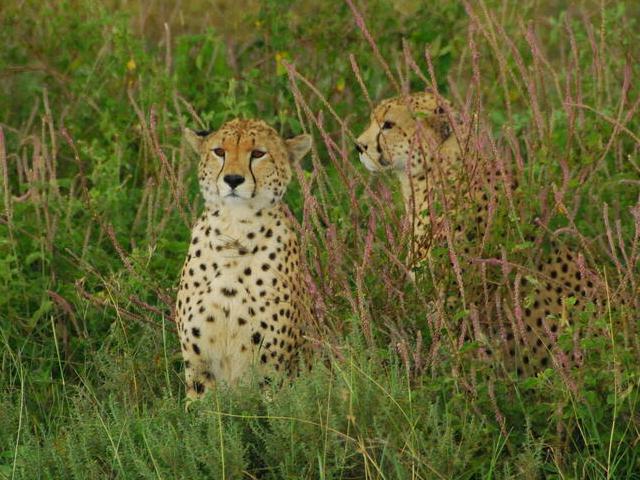When another male cheetah, Obaan,joined the two rock stars – Freddie and Elton -- in yet another bigger enclosure of Kuno national park on November 18, only five female cheetahs remained in smaller bomas in the park where they were released on September 17. Like the three males, the five female spotted cats will also be released soon in larger bomas to run and chase their prey to kill. India’s wildlife authorities accompanied by the experts from the cheetah conservation fund (CCF) from Namibia have been taking utmost care and caution before the cheetahs in Kuno are ultimately made “free -ranging” meaning released in open to move around the entire length and breadth of the park. “Free ranging cheetahs and their monitoring will be like a grand finale of the Project Cheetah to be played in Kuno for a longer period in the coming years'", said a senior official of the Union ministry of environment, forest and climate change (MoEFC&C).
Apprehensions, Concerns on Cheetah Project
As the whole world watches developments of the much hyped Cheetah Project, independent researchers, cheetah experts and biologists from India and abroad have expressed apprehensions over its success. Though Indian experts involved in the introduction of cheetah in India have rubbished the criticism and concerns, many wildlife scientists termed it “ an ill advised project”. The scientists, in an article titled “Introducing African cheetahs to India is an ill-advised conservation attempt”, published in Nature Ecology and Evolution, said that there are unknown ecological, disease-related and genetic risks involved in replacing Asiatic cheetahs with the larger cheetahs from southern Africa. “The plan ignores crucial scientific findings from important, recent demographic studies on free-ranging cheetahs. This can prove to be a costly mistake because the cheetah carrying capacities assumed in the plan relies entirely on projections made from a single, likely flawed, density estimate from Namibia from over a decade ago”, they said while raising among other issues questioning the project. Referring to the space crunch, conservationists said Kuno only has about 748.5sq km of area as compared to 15000 sq km and 20,000 sq kms and even bigger parks of Africa.
Also read: Urban Tigers In Bhopal Residential Areas, A wake-Up Call To Govt
"It is well established that even in the best of habitats (for example, the Serengeti-Mara ecosystem straddling Kenya and Tanzania), cheetahs exist in very low densities of around 1 per 100 sq km. Average female home ranges have been estimated to be about 750 sq km”, writes Ravi Chellam, senior scientist and CEO, Metastring Foundation & Coordinator, Biodiversity Collaborative. Given the size of Kuno, barely 10 cheetahs can be accommodated . But according to government data, an estimate says the national park can house as many as 21 cheetahs at present and, if necessary efforts are made and the prey base is maintained, it can potentially even hold 36 of them. Besides, there are doubts related to the Kuno’s terrain vis a vis cheetah .“ Kuno is a shrubland and the cheetah will have to learn fast the art of negotiating the hurdles in the forms of scrubs in the stony ground of the jungle while chasing a prey,” they said.
Preparing for The Finale
Amidst all these concerns, Freddie, Elton and now Obaan are enjoying the bigger enclosure. A dedicated team of experts have been minutely monitoring every moment of the trio. Every time they kill a prey, it becomes a reason to rejoice in Kuno. It makes the bureaucrats of the MoEFC&C happier. “Freddie and Elton have already killed five spotted deer eversince they were released in a 5 sq km area enclosure on November 6”, they highlight happily. Cheetal kill is being promoted as another step towards success of the project. Scheduling of cheetah release from small to bigger enclosure is a part of exposing the field staff with the animal for the grand finale- the day when all the cheetahs will walk out in open and wander around the entire length and breadth of Kuno, originally prepared for Gir lion translocation. MoEFC&C sources said that,” it is like introducing man and animal to each other and creating a rapport between the field staff and the cheetahs”.
Also read: Why Cheetahs in Kuno National Park Are Linked with International Ivory Trade ?
Accompanied by the experts from Namibia’s Cheetah Conservation Fund (CCF) , a team of India’s wildlife experts monitor the cheetahs roaming around the five sq km boma. “And while doing so, the animal is learning about the presence of the team members and vice versa”, said MoEFC&C officials, “ as they start knowing each other and develop a relationship, this will come in handy when cheetahs become free -ranging.” The same ground level staff is going to chase the satellite collared cheetahs when they start touching the boundaries Kuno landscape. Though cheetahs are not as robust as a tiger or a leopard, there is always the risk of man -animal conflict in the large number of villages with huge livestock presence around the Kuno landscape. The feral dogs may also pose a risk to cheetahs.
By Deshdeep Saxena
Representative images : Banner Pic from CCF,Smithsonian Magazine , Last Image from Wikimedia Commons
.




Comments
Post a Comment